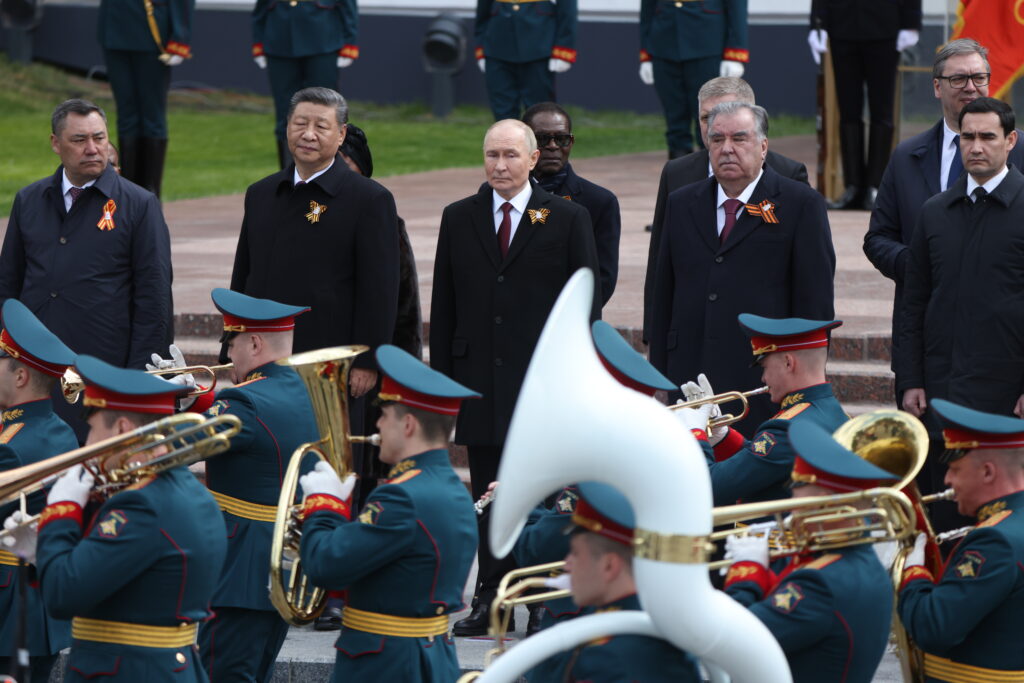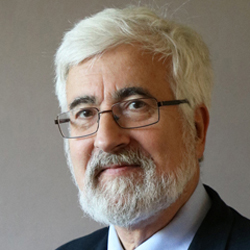Interviews
15 May 2025
9 May Parade: A Commemoration in Service of Russia’s International Strategy

While Russia has been subject to Western sanctions aimed at isolating it geopolitically since the invasion of Ukraine, Vladimir Putin welcomed numerous international leaders on the occasion of the national celebrations on 9 May. Coupled with a patriotic speech praising the bravery of Russian soldiers on the front line, the military parade orchestrated by the Kremlin featured an army composed of foreign soldiers, notably Chinese, Brazilian, Kazakh, Belarusian, Vietnamese, Armenian, Cuban, Venezuelan, etc. What message does this convey to Ukraine and its allies regarding the resolution of the conflict? To what extent does this parade highlight Russia’s strategy on the international stage? How is this show of strength received by the Russian population? We take stock with Jean de Gliniasty, Director of Research at IRIS.
Vladimir Putin stood alongside numerous heads of state and government during the national parade on 9 May. In light of the Russian president’s speech and the countries which took part in the ceremony, what can be deduced about Russia’s diplomatic strategy?
Russia has never been isolated on the international stage. What is commonly referred to as the “Global South” has, since the beginning of the conflict, considered that responsibility for the invasion of Ukraine (which it nevertheless condemns) is shared. In reality, the “Global South”, whose core is made up of the BRICS, represents the countries that refuse to apply Western sanctions and do not wish to suffer the consequences of the confrontation between the West and Russia over Ukraine. As the Russian armed forces asserted their dominance on the ground, the “Global South” expressed itself increasingly openly. The 9 May parade in Moscow was an opportunity for this, with the notable presence of Xi Jinping, Egyptian President Abdel Fattah Al-Sisi, and all the presidents of the former Soviet Central Asian republics. However, Moscow’s success was not complete: two founding members of the BRICS, India and South Africa, were only represented at a lower level. Moreover, the relative support of the countries of the South is the result of a long-standing policy of rapprochement, pursued with a certain degree of success by Russian diplomacy.
As manpower resources dwindle on both sides of the Russo-Ukrainian border, many foreign soldiers joined the Russian ranks during the parade. Through this display, what message is Moscow sending regarding the resolution of the war in Ukraine, just days ahead of its meeting with Volodymyr Zelensky?
The participation of foreign contingents in the 9 May parade on Red Square is not a novelty. A French detachment, for instance, took part in 2010, alongside other Western countries. However, the war in Ukraine has given particular meaning to the parade of foreign troops, a symbolism widely exploited by Kremlin communications. The agreement signed between Russia and North Korea allows for North Korean troops to be deployed in defence of Russian territory, for instance during the Ukrainian offensive in the Kursk oblast. In principle, however, the North Koreans should not be involved in supporting Russian operations on Ukrainian territory. That being said, all manner of contortions become possible when there is a pressing need for additional ground troops and Russia wishes to score points before agreeing to any negotiations. The Kremlin Guard Regiment has apparently been partially deployed to the front. Nevertheless, the need for manpower is less acute on the Russian side, thanks to the voluntary recruitment system — highly remunerated — introduced by the Russian government, which appears to be meeting with some success.
What response has this 9 May parade elicited among the Russian population, particularly in light of the Russo-Ukrainian conflict?
9 May is the true Russian national holiday, and few Russians are aware that the official national day, 12 June, marks the anniversary of the Russian Federation’s declaration of independence from the USSR. 12 June is viewed by some Russians, generally the older generations, as a fateful date symbolising the fall of the USSR… In contrast, the anniversary of the 1945 victory is a moment of unanimity, transcending political divides, which the authorities use to galvanise energy and instil lessons in patriotism — which are, moreover, very well received. As for Vladimir Putin’s speech, it is always brief, calling for unity and defence of the homeland. This year, the reference to the Special Military Operation (in reality, the war in Ukraine) indicated the meaning the Kremlin wished to assign to this display of military strength, diplomatic reach and national cohesion. However, the latest opinion polls conducted before the parade by the Levada Centre (designated a “foreign agent”) show that the proportion of Russians wishing to continue the war has reached its lowest level since the start of the hostilities — namely 30%.

